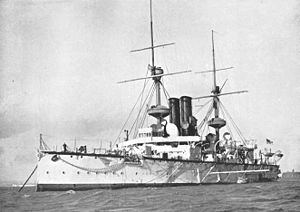 Centurion at anchor
| |
| History | |
|---|---|
| Name | Centurion |
| Namesake | Centurion |
| Builder | HM Dockyard, Portsmouth |
| Cost | £540,090 |
| Laid down | 30 March 1890 |
| Launched | 3 August 1892 |
| Commissioned | 14 February 1894 |
| Decommissioned | 1 April 1909 |
| Refit | 19 September 1901 – 3 November 1903 |
| Fate | Sold for scrap, 12 July 1910 |
| General characteristics (as built) | |
| Class and type | Centurion-class pre-dreadnought battleship |
| Displacement | 10,634 long tons (10,805 t) |
| Length | 390 ft 9 in (119.1 m) (o/a) |
| Beam | 70 ft (21.3 m) |
| Draught | 25 ft 8 in (7.82 m) |
| Installed power |
|
| Propulsion |
|
| Speed | 17 knots (31 km/h; 20 mph) |
| Range | 5,230 nmi (9,690 km; 6,020 mi) at 10 knots (19 km/h; 12 mph) |
| Complement | 606–620 |
| Armament |
|
| Armour | |
HMS Centurion was the lead ship of her class of two pre-dreadnought battleships built for the Royal Navy in the 1890s. Intended for service abroad, they exchanged heavy armour and a powerful armament for high speed and long range to counter the foreign armoured cruisers then being built as commerce raiders and were rated as second-class battleships.
Completed in 1894, Centurion was assigned to the China Station as its flagship. Together with her sister ship, Barfleur, she supported Allied operations during the Boxer Rebellion of 1899–1901 and contributed landing parties to participate in the Battles of the Taku Forts and of Tientsin. The ship returned home in 1901 to be rebuilt with a more powerful secondary armament. Centurion rejoined the China Station two years later and remained there until 1905 when she returned to Britain. Already made obsolete by the increasing speeds of the cruisers the ship was designed to defend against, she was placed in reserve until 1909. Centurion was decommissioned that year and sold for scrap in 1910.